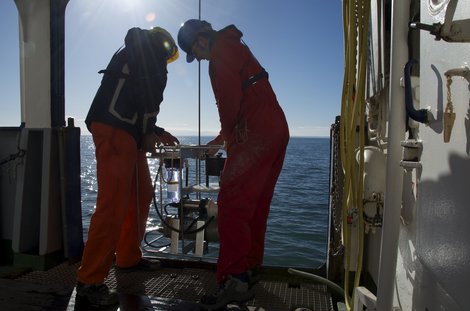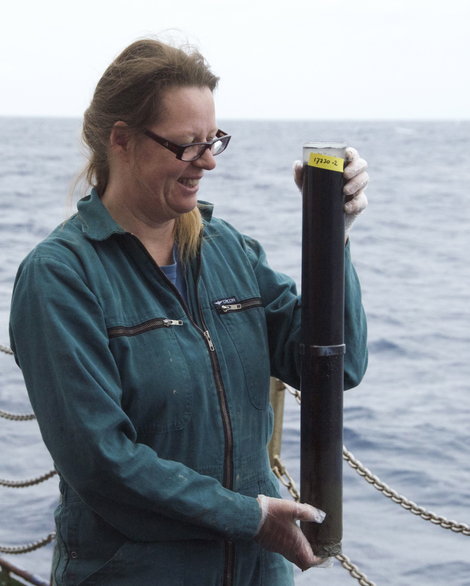- Startseite
- Karin Zonneveld
- Bachelor and Master projects
Bachelor and Master projects
Master Projects

(time interval of choise, for instance little icea age, Roman Warm Period, Medival Warm Period etc)
Aim: reconstruction of upper water temperaturtes and precipitation, pollution etc. in the coastal region off southern Italy.
Material/method: dinoflagellate cyst associations will be analysed by light-microscopy from core sediments. Organic fraction from core sediments will be concentrationd by chemical tratment (HCL and HF)
Knowledge to be present: General background knowledge about oceanography and dinoflagellate ecology
Special skills to be learned: Information about potential forcing factors (solar forcing, volcanic activity, differential climate modes etc.), combination with archeological information, Frequency analysis/wavelett analysis. Modern analogue techniques.
2. Did medieval Italian cultures pollute their coastal waters or did natural causes result in variations in nutrient content of these waters?
Aim: reconstruction of upper water pollution in the coastal region off southern Italy.
Material/method: dinoflagellate cyst associations will be analysed by light-microscopy from core sediments. Organic fraction from core sediments will be concentrationd by chemical tratment (HCL and HF)
Knowledge to be present: General background knowledge about oceanography and dinoflagellate ecology
Special skills to be learned: Information about potential forcing factors (solar forcing, volcanic activity, differential climate modes etc.), combination with archeological information, Frequency analysis/wavelett analysis. Modern analogue techniques.
3. Species selective preservation of organic-walled dinoflagellate cysts
Aim: determination of the species selective degradation rates of organic-walled dinoflagellate cyst species.
Material/method: Degradation rates of individual cyst species can be studied along oxygen gradients in core sediments. This can be executed along both active and fossil downward moving oxidation fronts (so called "burn-down events). For this we have world-wide unique material available e.g. from the Madeira Abyssal Plain .
Knowledge to be present: basic knowledge about organic geochemistry, basic knowledge about dinoflagellate cyst ecology, basic knowledge about oceanography, basic statistical knowledge.
Special skills to be learned: Information about special palaeoceanographic changes that occur in relation to oxygen minimum development (for instance sapropel formation, brine formation/ventilation), multivariate analyses, modern analogue techniques, chemical redox changes related processes in sediments .

Bachelor Projects
1. How does selective organic matter preservation influence palaeoceanographic reconstructions based on marine palynomorphs
Aim: Establish palaeo-environmental and -oceanographic reconstructions from perfectly preserved and sediments altered by degradation of organic-matter.
Material/method: World-wide unique sediment material is present for these investigations on the pollen/spore and/or dinoflagellate cyst content.
Knowledge to be present: basic knowledge on palynology.
Special skills and knowledge to be learned: Background knowledge about organic-matter degradation, special knowledge on palynology, multivariate analyse techniques
2. Seasonal production of organic or calcareous dinoflagellate cyst in an upwelling area off NW Africa.
Aim: determine the physical factors that steer the seasonal production and export of dinoflagellate cysts out of the upper water column.
Material/method: dinoflagellate cysts associations will be analysed from sediment trap sediments. Environmental data will be gathered from web-based databases.
Knowledge to be present: General background knowledge about oceanography and dinoflagellate ecology
Special skills to be learned: Multivariate analysis, use of ocean data view, extracting satellite data from web-based sources.
3. High temporal resolution reconstruction of temperature and precipitation in the eastern Mediterranean during the last 2000 years
(time interval of choise, for instance little icea age, Roman Warm Period, Medival Warm Period etc)
Aim: reconstruction of upper water temperaturtes and precipitation in the Italian region
Material/method: Dinoflagellate cyst associations will be analysed from core sediments. Archeological information will be gathered from literature.
Knowledge to be present: General background knowledge about oceanography and dinoflagellate ecology
Special skills to be learned: Frequency analysis/wavelett analysis. Archeological information


